On a sizzling-hot late-July afternoon in China’s barren northwest Xinjiang province, rote-learnt chants flow out of a dozen classroom windows as hundreds of Muslim students loudly repeat sentence after sentence after sentence. They are mostly studying Chinese – a language many of them have little grasp of – and taking classes in China’s national laws and regulations. Other groups are following courses in sewing, electronics, hairdressing and the local folk songs and dance.
The Shule County Vocational Training Centre, outside the city of Kashgar, is one of many recently established centres where an estimated 1.5 million Uighurs, Kazakhs, Krygyz and other Muslim minorities have been placed over the past few years.
We provide the students with free vocational education and deradicalisation work. We enhance their knowledge of rule of law, and keep them away from religious extremism
China says the centres are vital weapons in its “war on terror” where religious extremism can be wiped out while people simultaneously learn valuable skills. UN experts and western academics say there is evidence to show they are extrajudicial internment camps and part of an elaborate social re-engineering scheme aimed at diluting Muslim religious, cultural, linguistic and familial traditions, and assimilating the population into a Han Chinese way of life.
The director of the Shule centre, Mamat Eli, says his boarding centre was established “with the aim of eradicating the soil for spreading extremism and terrorism”. “We provide the students with free vocational education and deradicalisation work. We enhance their knowledge of rule of law, and keep them away from religious extremism.”
The director of another centre in Atushi, Hailait Jurat, says that “in the past some of the students were infected by extremism, terrorism and separatist thoughts, and some of them committed minor offences that could be exempted from criminal prosecution”.
Mamat says the students applied to come to the centres voluntarily after they realised they had broken some laws. “First, they must know they did something wrong and have a clear awareness and understanding about their behaviour. That’s why they choose to come here.”
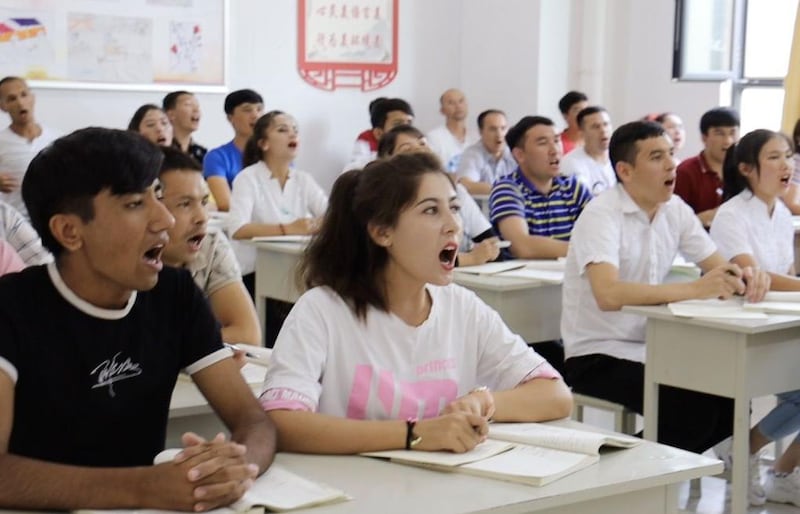
Before students are accepted for training, Mamat says, they first reach an agreement with them on the target of the vocational education and training as well as the standard for graduation, “and then once that is agreed we provide them with free vocational education and deradicalisation work”.
The length of time they stay in the centre is up to the students, he says. “Some are quick at reaching the targets and meeting the required levels, some are slow. It depends on them. As soon as they hit the targets they can graduate and leave.”
Both centres are in walled compounds with comparatively low security at the gates. The directors say students are often permitted home leave but have to apply before they can leave the centre.
The Irish Times is allowed to meet briefly with several trainees, and they all have very similar stories to tell.

Kuer Banjiang, who is 25, has been in the Shule centre for almost a year, and he is about to graduate. Like many of the other trainees, he says he had read extremist religious passages and watched extremist videos and other materials online and circulated them to some of his friends.
He says the materials mostly said “we are ethnic Uighers, and Uighers are born to be Muslims but we are living in a non-Muslim country with Han Chinese and other people who do not believe in Islam. They are pagans, so we should find opportunities to kill all of them or drive them away, out of our land.”
But he goes beyond what others say when he claims he had been preparing to build bombs.
“I searched for some information on how to kill pagans. For instance on how to make home-made bombs. So I searched on the internet for information, and I myself did buy matches, fireworks, batteries and other things for making bombs, and I asked several of my friends to prepare to make bombs.”
I think it is a good programme for those who are infected to eradicate any extremist thoughts that are on their mind… I really want to thank the government and the Chinese Communist Party
All the others say they had watched and passed on extremist videos, and had hated “pagans” and wanted them dead or gone. But they had not actually started to prepare terrorist acts.
Maj Stulam, a 28-year-old at the Atushi centre, says: “After attending illegal preachings several times I started to hate ethnic Han and non-Muslim people. I thought the Muslim kids should not attend the same school as the non-Muslim pagan kids. When non-Muslim kids came to my house I would not let them in, and I scolded them and I beat them,” she says.
“The illegal preachers said that we should kill the pagans and drive them away and establish a country of our own, East Turkestan Islamic Movement. I actually thought about killing pagans at that time.”
Gulimire Aiziar, who is 29, recently spent a year in the Kashgar centre, for circulating violent terrorist and religious extremist materials online.
Her story of how she came to be in the centre is uncannily similar to all the other testimonies, most of which sound as if they were rehearsed and recited from memory.
In conclusion, they all say that after a conversation with local police, an official, a friend or a family member they had an epiphany, saw the error of their ways and entered a centre to rid themselves of any radical or extremist thoughts.
“A policeman from the village committee came to me and talked to me, and told me that what I was doing was illegal, and he educated me,” Gulimire says.
“Initially I didn’t believe him, but I soon realised that what I was doing was very wrong and I was infected with extremist thought. So I talked to my family and reached an agreement with them, and I voluntarily applied for the vocational and educational training so that I could be free from any extremist thought.”
She now works in a clothing factory earning 1,200 renminbi, or about €155, a month – a job the centre arranged for her – and is reunited with her six-year-old son.
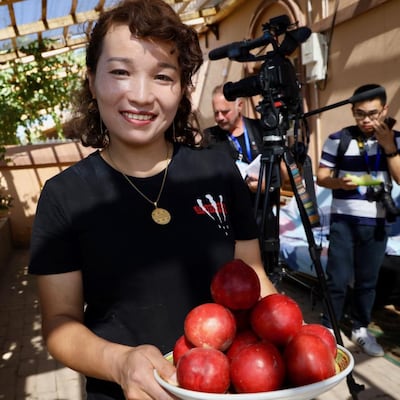
“Anyone who is infected with extremist thoughts can voluntarily apply for this vocational and training programme, and people would also recommend this programme to them if they thought they were affected by extremist thoughts.
“So I think it is a good programme for those who are infected to eradicate any extremist thoughts that are on their mind… I really want to thank the government and the Chinese Communist Party for providing this very good opportunity of free education for me.”
Kuer Banjiang, the young man who had been preparing bombs, says the local police found out what he was doing and came to talk to him.
“They spoke to me about my behaviour, and I realised I was doing something extremely wrong. So I voluntarily applied to come to the centre. It was my own decision. I wanted to remove those extremist thoughts from my mind.”
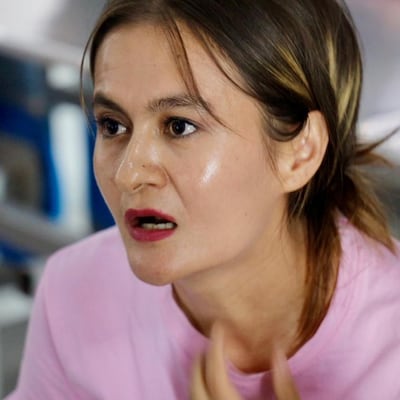
Maj Stulam says her behaviour had angered her husband and they had quarrelled and finally gone to court to initiate divorce proceedings.
“The people in the divorce court told me I was infected by extremist thoughts and said I was doing something illegal, and I realised my mistake after they told me those laws and regulations. So I voluntarily applied for a position in this vocational and training centre. I am very glad I did, and very grateful for this free education opportunity and chance to remove those extremist thoughts from my mind.”
Several other people in the centres recount almost identical experiences. They all say they still follow Islam but no longer harbour extremist thoughts.
Darren Byler, an anthropologist and lecturer at the University of Washington who has been researching the Uigher community and the Xinjiang region for more than 15 years, says that in almost all cases people are first brought to detention centres and interrogated, and they can spend up to a year there.
When people tell you in the camps that it was voluntary, it was voluntary in the sense that if they didn't choose the camp they would have probably gone to prison
“It’s in that space where they are being interrogated, assessed in terms of whether they should be given a prison sentence, and maybe they are charged with a crime and they show them leniency and say that, instead of following through with a prison sentence, we will give you the chance to reinvent yourself by sending you to the camp,” he says.
“So when people tell you in the camps that they chose to come to the camp, that it was voluntary – it was voluntary in the sense that if they didn’t choose the camp they would have probably gone to prison. In many cases going to the camp is a plea bargain.”
These are technically camps, he says, because people are not tried beforehand, and they are held indefinitely – and we should take their testimonies with a pinch of salt. “It might be true, or an exaggeration, or a total fabrication,” as once people are in the system they tend to say what they think the officials want to hear.
For a long time China denied the centres existed, but it recently switched approach, with Beijing defending them as a sensible anti-terrorist measure that other countries should emulate.
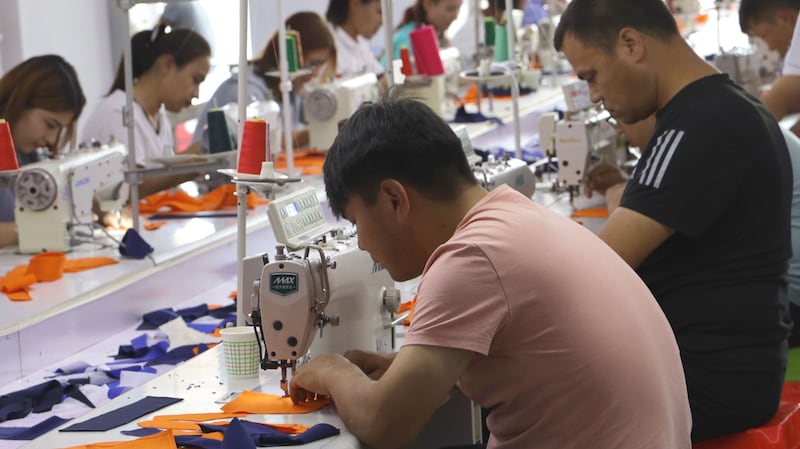
The visit The Irish Times is on is one of a series arranged this year for groups of diplomats and journalists – who often suspect that the carefully choreographed tours are to sites that fit the government narrative and portray the situation in the most favourable light. (When The Irish Times asked if the schedule could be adjusted, and visits made instead to random centres not on the itinerary, the request was denied for “logistical reasons”.)
The centres on the itinerary last week are low security and “not representative of camps in general,” Byler says. “Most camps have much more security – they are medium-security prisons in terms of the security apparatus.”
Although the authorities have pledged full transparency on the camp issue, they have as yet failed to answer two basic questions asked by The Irish Times and others: How many camps are there? And how many people have been put into the system to date?
At one meeting with members of the Chinese Academy of Social Sciences, a government think tank, a foreign journalist referred to reports that indicated the numbers in the camps could exceed three million. “That’s ridiculous, that’s beyond our capacity,” an official responded, but he then declined to say what the capacity actually was.
Given the lack of official information, independent researchers and human-rights groups have been sifting through government documents, interviewing widely and monitoring satellite imagery in an effort to establish the extent of this campaign.
According to Adrian Zenz, 'this is an unprecedented internment campaign, the largest incarceration of a particular ethnic minority since the Holocaust'
A German academic, Adrian Zenz, did a county-by-county analysis of government documents and local media reports in the region last year and concluded that at least a million people were in the camps.
A group of Han Chinese human-rights activists did an extensive village-by-village research programme, and established that 10 per cent of the local Muslim population had been taken to the camps in most regions, and independently of Zenz also came up with a figure of a million or more.
Byler says there are at least 180 camps in Xinjiang. Based on his own research and updated numbers he is seeing from others groups and researchers, he estimates that there are currently about 1.5 million people in the camps.
According to Zenz, “this is an unprecedented internment campaign, the largest incarceration of a particular ethnic minority since the Holocaust.”
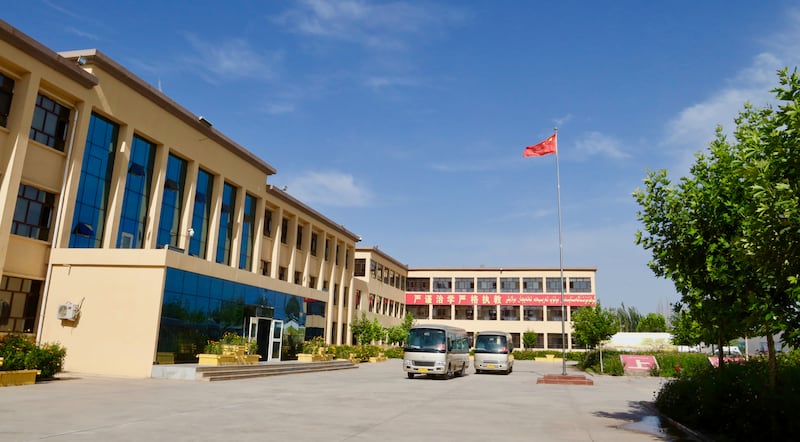
On Xinjiang government websites, Zenz has found numerous official references showing that brainwashing is a key element of the work in the centres. “Vocational Skills Education Training Centers wash clean the brains of people who became bewitched by the extreme religious ideologies of the ‘three forces’ [terrorism, extremism and separatism],” one government site read.
It appears, however, the numbers being sent to the camps has slowed since the peak in 2018, according to Byler. “And we are also seeing a slowing in the construction of new camps. All the way through 2018 we were seeing a lot of building of new camps or extending existing camps, and I think that has slowed a bit.”
But the camps are only one element of an expansive social-reengineering plan, according to a recent detailed report by Zenz called Beyond the Camps: Beijing’s Grand Scheme of Forced Labor, Poverty Alleviation and Social Control in Xinjiang, which uses local-government documents as its key source.
He says the other two key pillars in the scheme are involuntary labour in factories and moving Muslim children into state-run kindergartens. In both of these environments only the Chinese language can be used, religious practice is forbidden, and levels of indoctrination continue to be high.
Those who resist being 'alleviated' from their 'poverty' are subjected to ideological education so that their thinking aligns with the state's goals
Zenz describes the campaign as “a perverse and extremely intrusive combination of forced or at least involuntary training and labour, intergenerational separation and social control over family units. Much of this is being implemented under the heading and guise of ‘poverty alleviation’.”
He says that although poverty-alleviation schemes in general are to be welcomed, the issue in Xinjiang is that the scheme is targeting predominantly Muslim ethnic minorities on an enormous scale, and it is “coupled with penetrating social control, a pervasive surveillance state, an unprecedented extrajudicial internment campaign, and a deeper social re-engineering intention on the side of the state that effectively amounts to targeted cultural genocide” .
The factories that are for the graduates of the camps are normally inside the walls or they immediately adjacent to them, Byler says, adding that people are usually assigned to those factories for up to three years.
The government gives the factory a subsidy to train the workers and maintain a tightly controlled, Chinese-speaking environment. They provide the workers with a bed in a dormitory and food, “and sometimes it is unpaid labour, sometimes there is an allowance given”.
Local factories not affiliated to camps pay a salary, but in reality people don’t have a choice if they want to work there or not. “If anyone resists the poverty-alleviation programme that should be reported, that’s a sign of resistance, and so they might be sent to the camps,” Byler says.
As the campaign is “fine grained” there are highly detailed files and databases that show the status of every individual and their family, and no one is to be missed. If anyone refuses work in the factories or objects to sending their young child to the state-run kindergarten they are considered suspicious and risk being sent back to a camp.
“Those who resist being ‘alleviated’ from their ‘poverty’ are subjected to ideological education so that their thinking aligns with the state’s goals. After all, placing people into wage labour is not only and not even primarily an economic goal. Rather, it is very much an ideological goal,” Zenz says.

There is no hiding, as Xinjiang is one of the most monitored places on the planet. Facial-recognition technology integrated into the huge networks of cameras, iris biometrics, harvested DNA data and a mobile app used by police to access a mass surveillance database designed to closely monitor behaviours are all part of a pervasive surveillance set-up.
More than 100,000 additional police were recruited in Xinjiang recently, and there is a police station every few hundred metres along most main roads. At frequent checkpoints, police check and update detailed databases before letting people pass.
Even living abroad, people from the province are not safe if they speak out about the scheme. Numerous Uighers who have left China and live overseas have reported receiving explicit threats to themselves and their relatives still living in Xinjiang if they publicly criticise China.
Powered by digital information systems and financed by poverty-alleviation budgets, this scheme represents Beijing’s “long-term solution to establish ultimate social control and in-depth generational change towards the Chinese Communist Party ideology in this restive region”, Zenz says.
As men and women are herded into factories while their children are moved into educational facilities, the dissolution of traditional, religious and family life is only a matter of time
“As men and women are herded into factories while their children are moved into educational facilities, the dissolution of traditional, religious and family life is only a matter of time.”
Analysing satellite imagery, researchers have found that dozens of mosques and Islamic shrines have been razed over the past two years across the province, and in March the local government introduced measures prohibiting “abnormally” long beards and the wearing of veils.
Earlier this month 22 western countries, including Ireland, sent a letter to the UN Human Rights Council criticising China for the mass detentions and other human-rights violations of Muslims in Xinjiang. The United States, which is no longer part of the forum, did not sign the letter, but the US secretary of state, Mike Pompeo, recently condemned the Xinjiang situation as “the stain of the century”.
In response to the letter, a group of 37 countries – including Russia, Saudi Arabia, Pakistan and North Korea – submitted an opposing statement supporting China’s “counter-terrorism and deradicalisation measures in Xinjiang”.
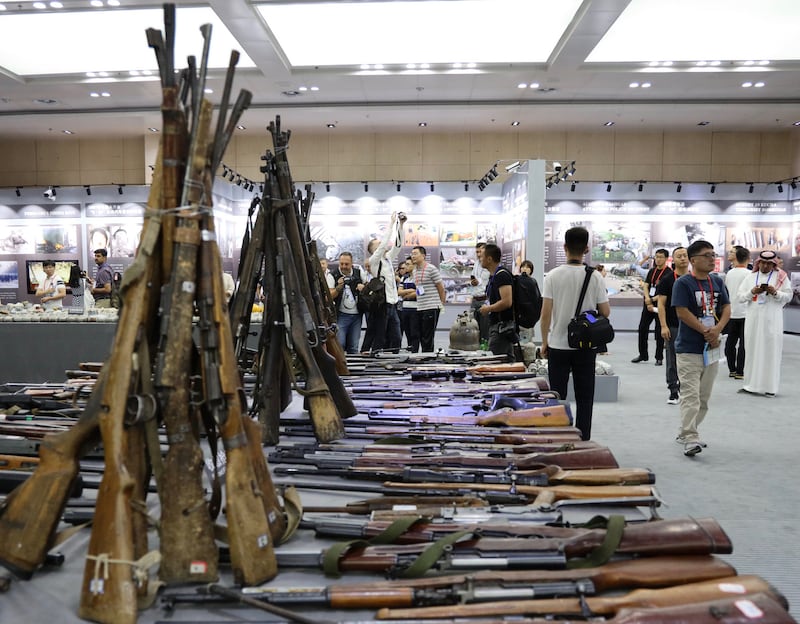
Xinjiang has long been a fraught province. The separatist East Turkestan movement claims it has been under Chinese occupation since the founding of the People’s Republic of China, in 1949; Beijing says the region has been part of China since ancient timeS. The province has witnessed occasional terrorist attacks and clashes between separatists and the police, but there have been no terrorist attacks in the province for the past three years.
Byler suspects the dramatic ratcheting up of the government campaign against extremism is partly linked to the fact that an estimated 5,000 Uighers fought in Syria in recent years, and Beijing fears escalating separatist activity on home soil.
“The Chinese state was very concerned about it,” he says, which might explain to some extent why they detained returnees and significantly developed the camp scheme.
Zenz believes that the government’s ultimate goal in Xinjiang – as elsewhere in China – is to exercise complete ideological supremacy, which includes trying to transform the very identity of the country’s minorities.
“The Communist Party of China lives in perennial fear that, short of having a complete grip on Chinese society, its long-term survival is in danger.” By targeting family, religion and language it is all “a process of elimination”, Byler says. “Cultural genocide is by definition what we are seeing here – the systematic removal or elimination of cultural systems or social institutions.”
There is a very calculated approach to the scheme, Byler adds, with a quota system in place: government officials in each region are doing what they are doing based on numbers that need to be met.
“So there is a sense of a ‘banality of evil’, in the sense that was talked about in the 1940s when in Germany there was a form of accounting that needed to be done,” he says. “How many people need to be put in this camp, what is the capacity of the camp, how many people can graduate and go to the factories? There are lots of ways that this just turns into numbers and budgets, and it becomes systematised and normalised through the process.”
“We haven’t ever seen this before, I think, in history: the use of technology, the use of the factories, the targeting of religion and the re-education of people,” Byler says. “That to be done on such a systematic scale is new, but of course it is related to all the camp systems that have existed throughout time.”
















